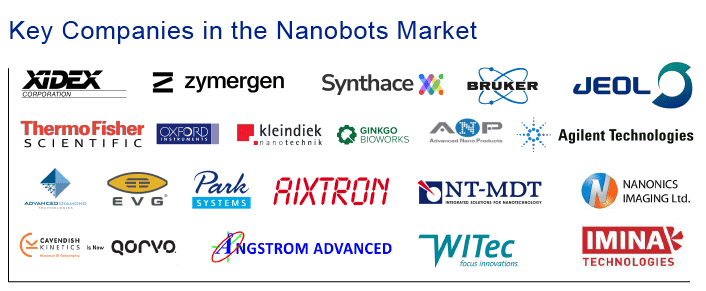How are Nanobots Proving Their Excellence in the Healthcare Industry?
Jul 20, 2022
Table of Contents
It is estimated that around five billion people are on the verge of losing access to essential healthcare services by 2030, for example, mandatory healthcare services, necessary medicine, and visiting healthcare providers. This issue can further become complex if there is an increase in the shortage of trained healthcare workers that too at a time when they are needed more than ever.
This gap needs to be acknowledged, and the urgent need to make futuristic medical technology a reality needs to be highlighted. The advanced MedTech includes a wide array of practices, equipment, and strategies, but one of the most game-changing, emerging technologies available in the healthcare field today is Nanobots.
Downloads
Article in PDF
Recent Articles
- Eko’s AI-powered Sensora Platform; SOPHiA GENETICS and QIAGEN Announced Partnership; Co-Diagnosti...
- Revolutionizing Pain Management: The Growth in Innovative Devices and Rise of Market
- With advancements in Innovative Technology, Cardiac Monitoring Devices Market is Booming Signific...
- Fujifilm acquires global rights to Cynata’s novel therapy for GvHD; Themis raises EURO 40 m...
- Is Gene Therapy the Next Cancer Treatment Revolution?
Nanorobots or known as Nanobots, are miniature robots of sizes ranging from 1 to 100 nanometers, which is 10-times smaller than a normal blood cell. Nanobots in healthcare primarily focus on medical diagnosis and monitoring. The nanobots enter the body through direct injection into the bloodstream and then act as an internal surveillance system for the human body. These bots can sense changes in environmental stimuli and check for a molecular assembly. Also, Nanobots diagnose any concerning health conditions. Nanobots, in combination with next-generation software platforms, can be utilized as a strong diagnostic and monitoring tool. Healthcare service providers use Nanobots to observe and monitor a patient’s health in real-time, capture their daily dietary needs, and administer medicines.
Challenges in Building Nanobots
Definitely, there have been significant advancements made in the development of nanobots through the years, but there are some challenges that need to be addressed while producing these Nanobots. Some roadblocks are navigating the high cost of development, determining a constant power source and establishing the use of non-reactive materials, integrating nanobots in medical diagnosis and treatment while following government regulations, and also ensuring the secure delivery of patient data to appropriate sources. On top of that, factors like defining the range of signal strength and connection to wireless networks and devices for successful data transmission and using biodegradable/non-biodegradable material in the short-term and long-term treatment and the subsequent safe removal from the body, and determining that lifespan also becomes essential factors to be taken care of while building Nanobots.
Medical Applications of Nanorobotic Systems
Nanorobotic Systems can have various potential uses in the healthcare system. Currently, the conceivable uses are for diagnosis, treatment, and surgery, and research is going on to get the desired result in the respective fields. With technological advancement, nanorobotics is expected to have several new medical applications and are expected to bring major transformations in cancer treatment, diabetes monitoring, wound-healing (regenerative medicine), dentistry, and blood monitoring (blood clot), among several others.
Nanorobotics comprises various nanoscale size components, and each of the components can be built to carry out a specific function. The different components can perform tasks such as sensing, actuating, signaling, processing information, or exhibiting swarm behavior at the nanoscale level. For example, in the case of diagnostics and screening, the ultimate aim is to reach an area in the body where passive nanoparticles cannot go. The Nanorobotic can be used as a contrast agent for the imaging of a particular area of the body.
Similarly, the Nanorobotic can carry a drug and molecule to a particular location of interest in the body. Also, with the help of Nanorobotics, the drug can be administered in a more organized way to a small targeted region. In the case of serious illnesses like cancer and heart disease, Nanorobotics can play a critical role in targeting the cancer cells and delivering more optimized treatments for various cardiovascular diseases. As of now, applications of Nanorobotics are in the research phase, and none of the systems has made it to the clinic phases. Nanorobotics is an exciting and promising field of research and is currently in the nascent stage. With the ongoing active research in the domain and investment by prominent healthcare companies, Nanobots are expected to make it to clinical use in the future.
Nanobots for Cancer Treatment
Nanorobotics is a new subfield of nanotechnology concerned with designing and fabricating devices at the atomic, molecular, and cellular levels. These envisioned nanorobots will be extremely small and will circulate in human blood. Because they contain unique sensors that distinguish target molecules, these nanorobots can be trained to diagnose and treat fatal diseases. One of the most intriguing areas of research is the use of nanorobots in cancer treatment. The current cancer treatment approaches are ineffective since 99% of chemotherapy medications do not reach cancer cells. However, nanorobots, which are around 100 times smaller than human tissues, might achieve this, opening up a vast new area of biomedical research. According to scientists, cancer will become a chronic but controllable disease in the coming years.
However, researchers are already testing DNA robots to find and eliminate cancer cells. Programmed DNA strands travel through the bloodstreams of animals, delivering clotting medicines into blood arteries surrounding tumors to cut off blood flow. Nanobots might deliver cancer-fighting chemicals, such as radioactive substances, directly to tumors (even across the blood-brain barrier).
Unlike a drug supplied to cure cancer, where the effectiveness is all that matters, we need to understand the process, the movements that occur inside the body, and so on with nanorobots. That’s far more difficult, and there’s no good way to do it just yet, though computer models have begun to aid in this area. Finally, while nanorobotics is promising, so are many other modes of treatment, diagnosis, or just monitoring. Furthermore, other alternatives, like immunotherapy, are years ahead in terms of development.
Nonetheless, it is encouraging to see innovative solutions addressing long-standing issues. Nanorobotics is still an attractive prospect and a growing trend. Perhaps, with luck and sooner than we expect, nanorobotics will become commonplace in the field.
Nanobots Market Dynamics
Advances in molecular robot technology are increasingly being used in the healthcare industry to complete difficult operations and reduce human error. Recent DNA nanotechnology research promotes the use of nanorobots in regenerative medicine on a large scale, which is expected to contribute to nanobots market growth. Nanotechnology will be employed in the medical field to help with disease identification and treatment, such as diabetes. Furthermore, the expanding application areas of microscopes, as well as the merging of microscopy with spectroscopy, are expected to give new prospects for the growth of the nanorobots market in the coming years.
On the other hand, the application of excise tax and substantial custom duty on nanorobots in the medical industry is expected to restrict the growth of the nanorobots market. However, the commercialization of nanorobotics systems may provide further challenges to the growth of the nanorobots market in the near future.
Benefits of medical robots
Nanobots are emerging and promising technologies in the field of nanotechnology. It can provide immense benefits to the healthcare industry ranging from early diagnosis to targeted drug delivery and monitoring the disease to performing complex surgery. Additionally, it can play a major role in biomedical instrumentation, pharmacokinetics, and cancer. It is set to transform the overall dynamics of the healthcare industry.
Nanobots are much smaller in size, which makes them suitable for performing an incredible task that requires a fine and precise scale of operation. They can improve performance and deliver the desired results in a short time as compared to the existing time method of operations. Additionally, they can reduce human errors and can deliver tailored and customized treatment. Overall they are intended to increase healthcare efficiency and effectiveness.
In today’s time, human stress & workload is a major concern for the healthcare industry. Nanobots can perform repetitive and customized tasks that can streamline the operation. With Nanobots in use, the workload and stress of doctors, nurses, and other medical professionals can be reduced to a significant extent. The healthcare workers can be more focused.
Overcoming challenges of nanobots
Nanobots in the healthcare industry have promising applications. The emerging nanobots are expected to emerge as a promising potential solution to the existing medical diagnostic devices and medical practices in the coming years. But they have several associated challenges that need to be addressed for their wide-scale adoption.
Currently, nanobots are in the initial research phase of research and development; companies are investing heavily in R&D activities. The high development cost is expected to hamper the nanobots market growth as companies may focus on recovering the initial investment. Similarly, countries worldwide follow different criteria to approve and use medical devices in healthcare. Healthcare and MedTech companies need to follow different government regulations. The stringent and evolving government regulations are expected to create a major roadblock in the launching and marketing of nanobots for diagnostics and treatment.
In the case of drug delivery and imaging/diagnosis, nanorobots are dispatched inside the human body for a short-term and long-term time period, depending upon the need. The biodegradable/non-biodegradable materials used in the nanobots must be safely removed from the body. In some cases, it may trigger some harmful activity in the body. Moreover, the privacy and the security of personal health data have always been major issues in the healthcare industry. Nanobots collect the vital health data of the patients. To boost the user’s confidence, the companies in the nanobots market and healthcare/clinics need to ensure the end-to-end safety and security of patient data. Similarly, Nanobots are made up of several components which perform different functions. Nanobots need to have strong signal strength to ensure seamless and wireless data exchange across the networks and devices.
Leading Players in the Nanobots Market
Nanotechnology has flourished in recent years, with research expanding and developing new and interesting applications that take advantage of nanoparticles’ unique features, particularly in health, electronics, and materials science. The emergence of nanobots in healthcare is giving a lot of opportunities to several market leaders as well as newcomers to develop innovative products to reduce the healthcare burden.

Currently, the major MedTech goliaths such as Xidex Corp., Zymergen Inc., Synthace Limited, Bruker Corporation, JEOL Ltd., Thermo Fisher Scientific, Oxford Instruments, Kleindiek Nanotechnik GmbH, Toronto Nano Instrumentation, Ginkgo Biowork, Advanced Diamond Technologies and Advanced Nano Products Co Limited, Agilent Technologies, Inc., EV Group (EVG), Park Systems, AIXTRON, NT-MDT SI, Cavendish Kinetics, Inc., Nanonics Imaging Ltd., Angstrom Advanced Inc., WITec Wissenschaftliche Instrumente und Technologie GmbH, Imina Technologies SA, and others are currently working in the nanobots market.
Future of Nanobots
Despite several challenges, there are tons of benefits accounted by Nanobots that can not be ignored. As the medical landscape evolves, Nanobots are anticipated to play a pivotal role in replacing the age-old medical diagnostic equipment tools and archaic medical methods with more modern and technically advanced approaches to treatment. Having the capability to access the health activities at an atomic level would enable healthcare providers to diagnose early onset of infections, identify potential diseases, and perform in vitro imaging and biopsies.
Downloads
Article in PDF
Recent Articles
- Cartessa Aesthetics teams with Classys for Everesse; LogicMark unveils Freedom Alert Max; GE Heal...
- Alnylam’s HELIOS-B Phase III Study of Vutrisiran; Bristol Myers Squibb Secures FDA Nod for ...
- Tempus Launches FDA-Approved xT CDx Test Nationwide; B. Braun Enhances Catheter Securement with t...
- B. Braun’s Introcan Safety 2 IV Catheter; Everly Health’s At-Home Collection Kidney Health Test; ...
- Roche’s Tecentriq combo proves effective in Bladder cancer



